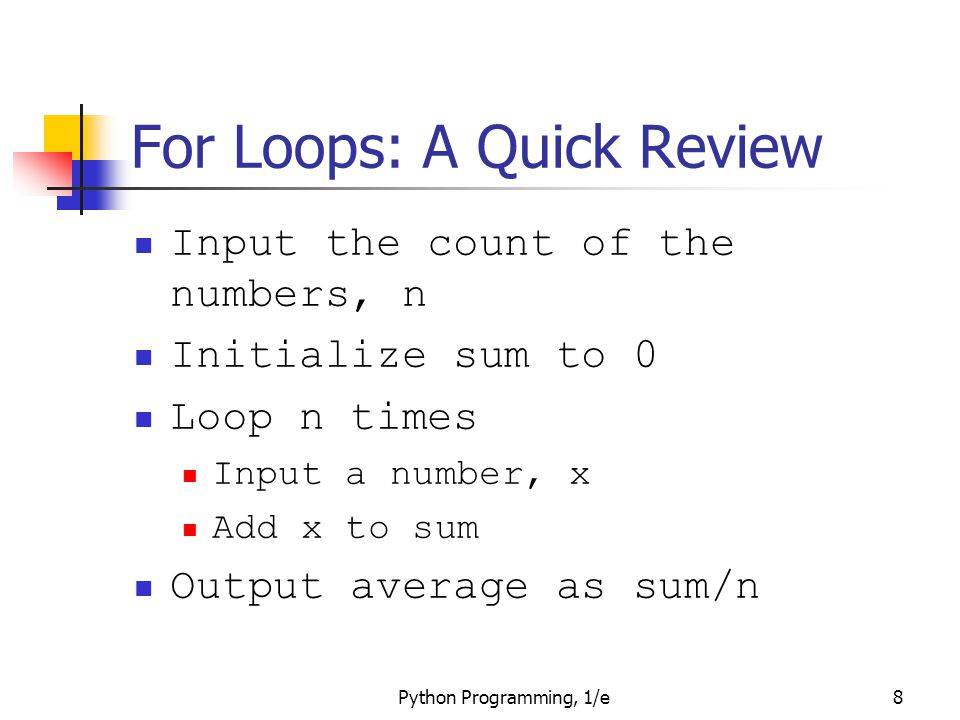In this post, you will learn how to use loops in Python.
Numpy.repeat in Python The numpy.repeat function repeats the elements of an array. e. n You should note that if e is for example an empty list you get a list with n references to the same list, not n independent empty lists. Performance testing. At first glance it seems that repeat is the fastest way to create a list with n identical elements. » Become a Python Wizard for $50 with the Complete Python Certification Bundle! In this post, you will learn how to use loops in Python. Loops are a commonly used structure in programming that. For loops are traditionally used when you have a block of code which you want to repeat a fixed number of times. The Python for statement iterates over the members of a sequence in order, executing the block each time. Strrepeat is defined by pattern-matching: repeating any string 0 times results in the empty string; while repeating it more than 0 times results in the concatenation of the string and (n-1) further repeats.
Loops are a commonly used structure in programming that allows you to repeat a block of code a set number of times, or until you meet a particular condition.
This is useful for many reasons. For example, if you are building a game, then you might want the bulk of your code to continuously “loop” while you update the position of enemies and check for player inputs. If you build a game in Pygame, then “game loop” will be one of the most important aspects of that code.
Also read: How to make a game in Python: An introduction to Pygame
More often, programmers need to learn how to use loops in Python so that they can perform iterative tasks. For instance, they might want to individually check all the files in a list, or they might want to look for something in a database.
Now you know what a loop is, the next question is how to use loops in Python!
How to use “for” loops in Python
There are two main types of loop across programming. These are “for” loops and “while” loops. For loops are used to run through a range – for instance all the items on a list.
You do this by setting the “range” in brackets.
Python Repeat Function N Times

For example:
This will print out the numbers 1-5. If you had a list, then you could likewise use this to run through the list and print each item:
This will show us the first five items on our list!
We can also use a for loop to show a section of items by using two numbers in our range: a starting number and an ending number.
This will show entries two through five! But remember that the first item in a list has the index “zero.”
Finally, we can actually change the iterator – the number of steps taken on each loop.
Python Repeat N Times List
This will go from the second (third) entry up to the 20th, jumping three places each time.
How to use “while” loops in Python

The great thing about Python is that a lot of its statements sound like plain English, meaning you can guess what they do before you even learn!
A “while loop” runs “while” something is true.
Here, you write “while” followed by a test statement, a colon, and a code block. The code block runs repeatedly until the test statement is no longer true:
This will run until n = 10. Remember that “<” means smaller than, and n += 1 means the same thing as n = n + 1.
Oh, and you can also stop the code at any time by using “break” or truncate your code (return to the for or while statement halfway through the code block) using “continue.”

So that is how to use loops in Python! It’s pretty simple, but if you combine this with if statements, you can accomplish all kinds of amazing things! Find out how to do this by reading our huge and comprehensive guide to the language here: Python beginners’ guide – Everything you need to know to get started!
Also read: How to use if statements in Python
Want to learn more? Anyone can become a competent programmer using Python by taking an online Python course. Check out our list of amazing deals at our guide to the best online Python courses.
Code can be repeated using a loop. Lines of code can be repeated N times, where N is manually configurable. In practice, it means code will be repeated until a condition is met. This condition is usually (x >=N) but it’s not the only possible condition.
Python Repeat Tuple N Times
Python has 3 types of loops: for loops, while loops and nested loops.
Related Course:
Python Programming Bootcamp: Go from zero to hero
For loop
We can iterate a list using a for loopVisualization of for loop:
Python Repeat N Times String
The for loop can be used to repeat N times too:
Python Repeat X Times
While loop
If you are unsure how many times a code should be repeated, use a while loop.
Python Repeat N Times Numpy
For example,Nested loops
Python Repeat Number Of Times
We can combine for loops using nesting. If we want to iterate over an (x,y) field we could use:Nesting is very useful, but it increases complexity the deeper you nest.
If you are new to Python programming, I highly recommend this book.
